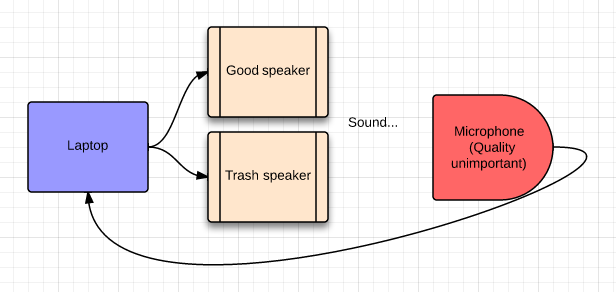-
Lets go for the hackaday prize!
08/20/2014 at 20:59 • 0 commentsIt's going well... Prize here I come!
-
Why are you using a shitty microphone?
08/20/2014 at 20:55 • 1 commentSo lots of people have asked me this...
It turns out in my diagram in the previous update that the microphone quality doesn't matter. Here's why:
I play a sound x through the good speaker (G), record it with the shitty microphone (M). I then do the same with the modified sound y and bad speaker (B), and analyse the difference.
Turns out I'm analysing:
M(G(x)) - M(B(y))
And since M is present in both terms, the eventual result after many repeats will be:
M(G(x)) ~= M(B(y))
G(x) ~= B(y)
So the microphone got cancelled out! (Note this is only strictly true if function M is invertible, but we'll assume it approximately is...)
-
"Feedback" you say?
08/20/2014 at 20:41 • 0 commentsSo I've got a few questions about my idea involving "feedback", which is normally a bad thing in the audio world.
Thats not always the case, and in fact it's very well researched. If you want to learn more, look here:
http://en.wikipedia.org/wiki/Nyquist_stability_criterion
In fact... Don't... Because thats one of those Wikipedia pages that's only good if you already have a PhD in the topic... Also, all that maths only applies to linear systems, which is the very assumption we don't want to make about our speaker!
The summary is this though: When you thing you have figured out what the speakers doing (ie. for a given input signal, you have figured out what sound it should make, and what sound it really makes, and hence the 'error'), if you apply the inverse signal to cancel it out, and the problem gets worse instead of better, then you've fallen foul of the Nyquist stability criterion.
Luckily, *for a given frequency*, if this happens and one instead adds instead of subtracts the error, you're guaranteed to end up with a stable system... Magic...
-
Just setting out...
08/20/2014 at 20:31 • 0 commentsI found my rubbish speaker... I found a microphone... I found a good speaker...
![]()
The goal is to play a sound with the good speaker. Then play one with the rubbish speaker. Then figure out the main differences in the sound via doing an FFT and looking for the most major differences.
Next, calculate a signal which will cancel the differences, and repeat the whole process with the new signal added in for the trash speaker only. Over time, the differences will diminish towards zero.
Good sound from bad
Lets use machine learning to make a bad speaker make good sound.
